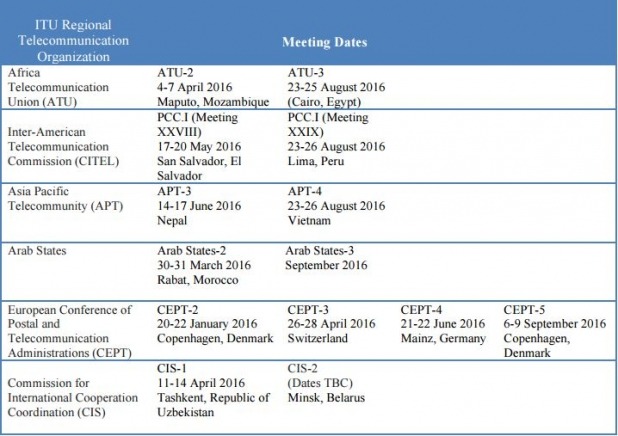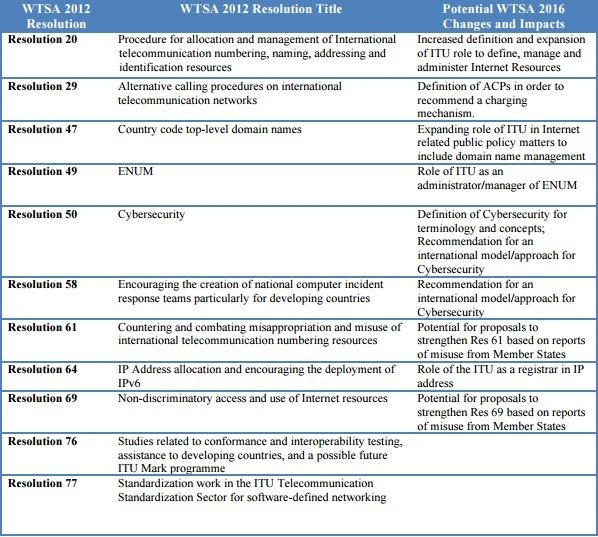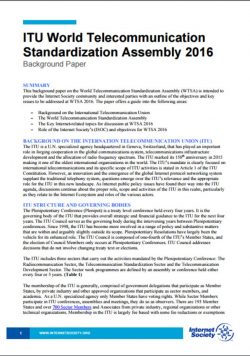SUMMARY
This background paper on the World Telecommunication Standardization Assembly (WTSA) is intended to provide the Internet Society community and interested parties with an outline of the objectives and key issues to be addressed at WTSA 2016. The paper offers a guide into the following areas:
– Background on the International Telecommunication Union
– The World Telecommunication Standardization Assembly
– The Key Internet-related topics for discussion at WTSA 2016
– Role of the Internet Society’s (ISOC) and objectives for WTSA 2016
For more information about Internet Society activities related to the WTSA, please visit our WTSA page.
BACKGROUND ON THE INTERNATIONAL TELECOMMUNICATION UNION (ITU)
The ITU is a U.N. specialized agency headquartered in Geneva, Switzerland, that has played an important role in forging cooperation in the global communications system, telecommunications infrastructure development and the allocation of radio frequency spectrum. The ITU marked its 150th anniversary in 2015 making it one of the oldest international organizations in the world. The ITU’s mandate is clearly focused on international telecommunications and its specific scope of ITU activities is stated in Article 1 of the ITU Constitution. However, as innovation and the emergence of the global Internet protocol networking system supplant the traditional telephony system, questions emerge over the ITU’s relevance and the appropriate role for the ITU in this new landscape. As Internet public policy issues have found their way into the ITU agenda, discussions continue about the proper role, scope and activities of the ITU in this realm, particularly as they relate to the Internet Ecosystem and roles of the various actors.
ITU STRUCTURE AND GOVERNING BODIES
The Plenipotentiary Conference (Plenipot) is a treaty level conference held every four years. It is the governing body of the ITU that provides overall strategic and financial guidance to the ITU for the next four years. The ITU Council serves as the governing body during the intervening years between Plenipotentiary conferences. Starting in 1998, the ITU has become more involved in a range of policy and substantive matters related to ICTs, which some Members States believe exceeds its scope. Plenipotentiary Resolutions have largely been the vehicle for its enhanced role. The ITU Council is composed of one-fourth of the ITU’s Member States, and the election of Council Members only occurs at Plenipotentiary Conferences. ITU Council addresses decisions that do not involve changing treaty text or elections.
The ITU includes three sectors that carry out the activities mandated by the Plenipotentiary Conference: The Radiocommunication Sector, the Telecommunication Standardization Sector and the Telecommunication Development Sector. The Sector work programmes are defined by an assembly or conference held either every four or 5 years. (Table 1)
The membership of the ITU is generally, comprised of government delegations that participate as Member States, by private industry and other approved organizations that participate as sector members, and academia. As a U.N. specialized agency only Member States have voting rights. While Sector Members participate in ITU conferences, assemblies and meetings, they do so as observers. There are 193 Member States and over 700 Sector Members and Associates from private industry, regional organizations or other technical organizations. Membership in the ITU is largely fee based with some fee reductions or exemptions available to Members that meet the ITU’s eligibility criteria. Sector Members may participate in the activities of the Sector to which they join including leadership positions of the Sector Study Groups and Sector Conferences. Associates participate in only one study group in a sector. Each sector has rules of procedures for decision making in study groups.
Table 1: International Telecommunication Union Sectors

THE WORLD TELECOMMUNICATION STANDARDIZATION ASSEMBLY
The World Telecommunication Standardization Assembly (WTSA-16) is the peak meeting of the ITU Standardization Sector (ITU-T) and will be hosted by the ITU in Yasmine Hammamet, Tunisia, from 25 October to 3 November 2016. Member States and Sector Members of ITU-T will come together during this 10-day period to define the work program and structure of ITU-T for the next four years. The activities of WTSA are outlined under Articles 13 of the ITU Convention. It follows then that during WTSA governments will:
- Consider study group reports in order to approve, change or reject draft Recommendations;
- Consider whether the current study groups and questions are still relevant and/or retain, modify, or dissolve them;
- Consider whether to add new study groups and questions that reflect new issues or priorities;
- Consider whether to add, retain or dissolve other groups;
- Agree on the scope and terms of reference for Study Group work programs;
- Review ITU-T Resolutions (WTSA & Plenipot) for modification or deletion; and
- Elect Chairs and Vice-Chairs of the Study Groups
- Consider other policy matters
WTSA ITU-T recommendations are consensus-based (with some exceptions) and non-obligatory. However, despite their voluntary status, some Member States adopt some of them into national laws and they become required international standards.
PREPARATIONS FOR WTSA-16
The work programme in ITU-T is organized and structured according to WTSA Resolutions that are reflected in the final WTSA proceedings. During WTSA-16, Member States will consider reports from the Director of the Telecommunication Standardization Bureau (TSB), Mr. Chaseub Lee, from the study groups and Telecommunication Standardization Advisory Group (TSAG) on activities from the previous study period (2012-2016).
From February to September 2016, the various study groups will hold their wrap up meetings for the year. The Study Group contributions include new questions for the new study period and Recommendations for deletion, modification or approval will be considered and reflected in the study group report. Additionally, ITU regional telecommunication organizations (e.g., APT, Arab States, ATU, CEPT, CIS, and CITEL) will meet in the months prior to WTSA-16 to prepare and consolidate regional views on issues important to each region and in the development of common regional proposals for WTSA-16. WTSA Resolution 43 (Dubai, 2012) calls for at least one regional preparatory meeting between 2015 and 2016. The regional organizations that are typically involved in developing common regional positions are referenced in Table 2.
Table 2: Regional WTSA 2016 Preparatory Meetings

KEY TOPICS AT WTSA 2016
The discussions at WTSA-16 influence the future direction of ITU-T and how the work program will be organized for the next 4-year study period. How the work program is defined as well as the changes that are made in Recommendations and WTSA Resolutions can impact the scope of the ITU’s mandate. The Internet public policy related issues likely to be addressed at WTSA-16 are as follows:
– Internet of Things: The Internet of Things (IoT) has gained tremendous traction in the ITU and is likely to be a key topic for WTSA-16. IoT has been studied in ITU-T since 2008 and is reflected in ITU’s WTSA-16 objectives: to increase ITU participation and relevance, to acquire new areas of work in emerging technologies and to position the ITU as the venue for international standardization. In view of recent contributions to Study Group 20 on Internet of Things and Study Group 17 on Security, the discussions will mostly focus on the potential security risks, privacy of data, and issues of interoperability of IoT applications and identifiers and numbering plans. It is important to note that Study Group 20 on the Internet of Things and its Applications for Smart Cities was newly created by TSAG in 2015 and was not fully supported by some Member States. The potential for an expanded ITU scope beyond its mandate and issues of duplication not only with other ITU study groups but also with external entities will take some prominence in these discussions.
– Cybersecurity: Predominantly SG-17. Cybersecurity and questions over the ITU’s role in this debate will likely make its way once again into the discussions at WTSA-16. The ITU’s role in Cybersecurity is governed by Plenipotentiary and WTSA Resolutions and guided by WSIS Action line 5 on “Building confidence and security in the use of ICTs,” ITU-T activities, in particular, focus predominantly on trust and security in the use of ICTs. There is also ongoing work in ITU-T to explore terms and definitions of trust and security, including cybersecurity. Cybersecurity was one of the more dominant and contentious topics in the Plenipotentiary Conferences 2010 and 2014. Should the discussions at WTSA-16 steer more closely towards defining cybersecurity, the concerns that were raised in 2010 and 2014 over ITU’s expanded role on this issue can be expected. In particular over how cybersecurity is characterized given the misconceptions and over inflation of terms for such a broad concept. Any changes to the terms within ITU recommendations or resolutions could set the precedence for an expanded role in the future.
– Over The Top Communications (OTT): : OTT, while never having been defined in the ITU, is yet another key topic expected at WTSA-16. The discussions will likely focus on economic implications of OTT services, classification of OTT for regulatory and financing structures, and the security implications of OTT applications, particularly related to security and privacy of data. WTSA-16 may see proposals for new work to look at the impact of OTT services on data traffic, and demands on network infrastructure and cost models for International Internet Connectivity. Decisions on OTT at WTSA-16 could isolate the ITU even more on Internet related matters, as delivery of all content could be considered “OTT” by many countries.
– Other Key Discussions:
- Identifier Technologies, including the Internet of Things, Digital Object Identifiers (DOIs) and the Digital Object Architecture (DOA);
- Mobile Financial & Banking services: Definition of mobile financial and banking; conformance and interoperability; security and trust;
- Mobile Roaming: Costs, termination fees, and regulatory models;
- ITU-T Reorganization: The ITU-T Review Committee identified inefficiencies and recommended a review and streamlining of study groups. There is potential for some reduction in ITU-T’s study group structure either by elimination of areas of duplication and/or consolidation of work items.
- Internet Resolutions likely to be discussed: Resolution 101: Internet Protocol-based networks;
- Resolution 102 – ITU’s role with regard to international public policy issues pertaining to the Internet and the management of Internet resources, including domain names and addresses; Resolution 130 – strengthening role of ITU in building confidence and security in the use of information and communication technologies; and Resolution 133 – role of administrations of Member States in the management of internationalized (multilingual) domain names. (See Table below)
Some of these discussions will occur within the context of broader policy concerns and the appropriate role for governments. Some policy issues related to tariffs, OTT regulation, numbering and security that emerged at the World Conference on International Telecommunications in 2012 (WCIT-12) and Plenipotentiary 2014 may also come up at WTSA-16. A key consideration is whether areas of consensus can be achieved on some of these issues. To the extent that they can remain relatively contained within the confines of WTSA or continue to play out in other ITU fora will be worth following closely particularly on the Internet public policy related issues.
Table 3: WTSA Internet Related Resolutions

ROLE OF THE INTERNET SOCIETY
The Internet Society (ISOC) is a Sector Member of ITU-T and ITU-D. ISOC believes that the ITU has an important role to play in the Internet Ecosystem: promoting core infrastructure development and cross border connectivity, allocating spectrum to enable the deployment of new technologies and services, and providing technical assistance and capacity building. ISOC supports the ITU’s role in creating an enabling environment and its international cooperation platform for telecommunications. Additionally, ISOC will engage in discussions and follow activities related to the Internet’s technical, social and economic development while continuing to urge that multistakeholder dialogue occur on these issues and that technical recommendations take into consideration Open Standards. As a note, ISOC recognizes and values the importance of a distributed model of governance where each stakeholder group has its own role and responsibility in the Internet Ecosystem. These elements are key considerations to achieving successful outcomes at WTSA-16 whereby the ITU’s role is clearly delineated within scope and mandate and that the ITU’s commitment to collaboration with other Standards Development Organisations is deepened.
Version History
- 23 Feb 2016 – Initial release
- 16 May 2016 – Updated text
- 19 May 2016 – Updated text
